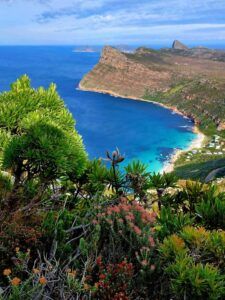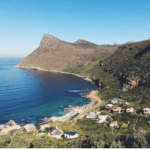Smitswinkel Bay
This name dates back to 1744. but it isn’t really clear where the beach got its name. Some say there was a blacksmith who lived in the area. Possibly it was named after a farm owner called Smit and then there’s the theory that two stones on the shoreline look like anvils hence the name. Possibly it was the site of sales of goods from shipwrecks. It is a secluded bay situated on the coastal drive between Simon’s Town and the entrance to the Cape Point Nature Reserve. It lies at the bottom of a cliff and is hidden beneath the curve of the road that leads to the reserve. It was first called Patience after the tiny stream that flows down a small valley into the bay as mariners who wanted to fill their water casks had to be very patient because of the slow trickle of water. Back then, Smitswinkel could only be reached by boat. Smit was a farmer who owned a property close to the beach.
In 1916 it was proclaimed as a camp-site Day hike permits are available and there is a tented campsite run by Sanparks. The beach is relatively inaccessible but can reached by foot down a very steep slope. It will take about 15 to 20 minutes to walk down the steep 120-meter zig-zag footpath to the beach. This discourages the crowds but for a diving adventure, it is well worth the effort. Bring with you enough water and food as there is no shop there despite the name. There’s also no electricity at Smits, Do not feed or encourage baboons as they can be dangerous.

This bay is an adventure for deep-sea dives where divers can explore shipwrecks. Five wrecks are here in the vicinity at a maximum depth of 34 metres. The wrecks were deliberately scuttled by the South African navy in the 1970s to make an artificial reef. Two frigates, the Good Hope and Transvaal and two trawlers Oratava and Princess Elizabeth were wrecked off the bay. Also the diamond dredger, Rockeater. When one dives the wrecks, large blast holes that caused the sinking can be seen in the sides of the ships. The SAS Transvaal was abandoned in 1978, MV Orotava in 1983, and the SAS Good Hope was sold for scrap metal in 1978.
The only catch is you have to go take scuba diving gear to view these abandoned sites but what an adventure! There is an extensive coral reef that has grown on the vessels which supports masses of aquatic life.
Residents (and their dogs) in the village use gas or opt for solar panels. It’s a beautiful beach, but it’s often windy and the water icy, and at high tide, the beach is almost completely underwater.
This beach is the last beach after Simon’s Town and the Cape Point Nature Reserve.
Check the tides here
GPS Coordinates : S 34° 15′ 52.92″, E 18° 28′ 1.2″


